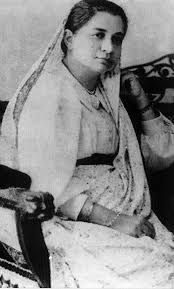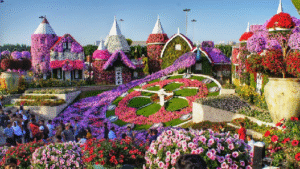Bhikhaiji Cama was a pioneering Indian freedom fighter who played a crucial role in advocating for India’s independence, particularly in Europe. She worked tirelessly to rally support for India’s freedom struggle, both among the Indian diaspora and the international communityOne of her most significant contributions was raising the Flag of Indian Independence at the International Socialist Conference in Stuttgart, Germany, on 22 August 1907. This act was symbolic of India’s growing nationalism and the resistance against British colonial rule. Cama’s raising of the flag marked a key moment in the visual representation of India’s fight for independence.
Cama’s Flag was based on the Calcutta Flag (1906), which was one of the first attempts to create a national flag for India. The Calcutta Flag had been raised in Parsi Bagan Square in Kolkata by Sachindra Prasad Bose and Hemchandra Kanungo on 7 August 1906.
The design of Cama’s flag had three horizontal stripes, each carrying distinct symbolic meanings:
Top Stripe (Green): Symbolized Islam, representing the Muslim community in India.
Middle Stripe (Saffron): Represented Hinduism, symbolizing the majority Hindu population.
Bottom Stripe (Red): Represented the Indian people as a whole, regardless of religion.
Located in the top green band, these represented the eight provinces of British India at the time.
The Slogan “Vande Mataram”: Written in Devanagari script on the middle saffron band, this slogan became one of the most iconic national songs of the Indian freedom struggle.
Crescent Moon and Sun: Positioned on the bottom red band, the crescent moon symbolized Islam, while the sun represented Hinduism, underscoring India’s diverse religious fabric and unity.
The Calcutta Flag (1906) is considered one of the first representations of a national flag in the Indian freedom movement. Although it was not officially adopted by the Indian leadership, it played an important role in unifying people under the banner of Indian nationalism.
Bhikhaiji Cama’s act of raising the flag in Stuttgart in 1907 was a moment of immense importance. It represented an act of defiance against British colonialism and was a powerful statement of India’s desire for independence. It also reflected the growing sense of national consciousness and solidarity among Indians living abroad, particularly in Europe.
The flag raised by Bhikhaiji Cama went through various modifications over time. Different leaders, factions, and groups within India developed alternative versions of the flag.
The Indian National Congress (INC) also developed multiple versions, and over the years, the designs were refined.
Eventually, the current Indian national flag, with its tricolor stripes (saffron, white, and green) and the Ashoka Chakra in the center, was officially adopted in 1947 after India gained independence.
- Bhikhaiji Cama raised the Flag of Indian Independence at the International Socialist Conference in Stuttgart, Germany, on 22 August 1907, marking an important milestone in India’s visual representation of independence.
- The flag was based on the Calcutta Flag (1906), with three horizontal stripes representing Islam (green), Hinduism (saffron), and Indian unity (red).
- It also included eight lotuses, the phrase “Vande Mataram”, and religious symbols (crescent moon and sun) that emphasized India’s unity in diversity.
- This flag was one of many early representations of India’s national flag and contributed to the growing nationalist sentiment, which eventually culminated in India’s independence in 1947.
In summary, Bhikhaiji Cama’s Flag of Indian Independence is an iconic symbol of early nationalist movements and remains an important part of India’s history of independence.







